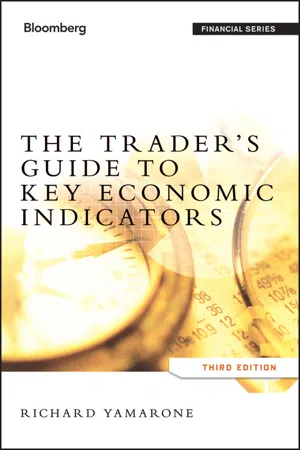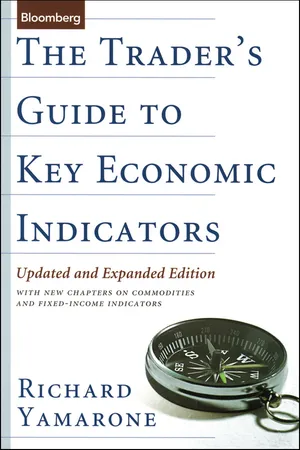Consumer Spending
Consumer spending refers to the total amount of money spent by individuals on goods and services within an economy. It is a key component of aggregate demand and is influenced by factors such as disposable income, consumer confidence, and interest rates. Consumer spending is a critical indicator of the overall health and direction of an economy.
6 Key excerpts on "Consumer Spending"
- eBook - ePub
- Richard Yamarone(Author)
- 2012(Publication Date)
- Bloomberg Press(Publisher)
...Department of Commerce, Bureau of Economic Analysis; U.S. Department of Labor, Bureau of Labor Statistics Growth in payrolls encourages spending not only by increasing disposable income but also by lifting consumers’ spirits. Another important influence on consumer expenditures is the level of taxation. When marginal tax rates are low, disposable personal incomes rise. With more of their earned income left over, people have a greater propensity to spend, and because Consumer Spending accounts for almost 70 percent of all economic activity, and the United States is traditionally a nation of spenders, economic growth will expand. Consumer Spending The connection between consumer expenditures and economic growth has already been well established. But not all spending is equally revealing of economic trends. Spending on nondurable goods such as food and home-heating fuel tends to be fairly constant, remaining positive even in trying economic times. In contrast, spending on durable goods, which are relatively expensive and long-lived, requires good economic conditions to flourish. In less flush times, consumers aren’t going to head out to buy stereos, furniture, or new china. Therefore, of all the subcomponents in the Personal Incomes and Outlays report, durable goods spending might be considered the most effective in calling turning points in the economy. The chart in Exhibit 11.4 shows that three of the last four recessions identified by the National Bureau of Economic Research—1981–1982, 1990–1991, and 2007–2009—were accompanied by simultaneous declines in the growth rate in Consumer Spending on durable goods. The 2001 recession broke this pattern, as automakers and certain other retail giants kept consumers buying their products by offering zero percent financing, hefty discounts, and other incentives. Spending on consumer durables barely fell below zero in 2001. EXHIBIT 11.4 Spending on Consumer Durables and Recessions Source: U.S...
- eBook - ePub
The Trader's Guide to Key Economic Indicators
With New Chapters on Commodities and Fixed-Income Indicators
- Richard Yamarone(Author)
- 2010(Publication Date)
- Bloomberg Press(Publisher)
...Department of Commerce, Bureau of Economic Analysis; U.S. Department of Labor, Bureau of Labor Statistics Growth in payrolls encourages spending not only by increasing disposable income but also by lifting consumers’ spirits. Another important influence on consumer expenditures is the level of taxation. When marginal tax rates are low, disposable personal incomes rise. With more of their earned income left over, people have a greater propensity to spend; and because Consumer Spending accounts for almost 70 percent of all economic activity, and the United States is traditionally a nation of spenders, economic growth will expand. Consumer Spending The connection between consumer expenditures and economic growth has already been well established. But not all spending is equally revealing of economic trends. Spending on nondurable goods such as food and home-heating fuel tends to be fairly constant, remaining positive even in trying economic times. In contrast, spending on durable goods, which are relatively expensive and long-lived, requires good economic conditions to flourish. In less flush times, consumers aren’t going to head out to buy stereos, furniture, or new china. Therefore, of all the subcomponents in the Personal Incomes and Outlays report, durable goods spending might be considered the most effective in calling turning points in the economy. Figure 11.4 Spending on Consumer Durables and Recessions Source: U.S. Department of Commerce, Bureau of Economic Analysis; National Bureau of Economic Research The chart in FIGURE 11.4 shows that three of the last four recessions identified by the National Bureau of Economic Research—1981- 1982, 1990-1991, and 2001—were accompanied by simultaneous declines in the growth rate in Consumer Spending on durable goods. The 2001 recession broke this pattern, as automakers and certain other retail giants kept consumers buying their products by offering zero percent financing, hefty discounts, and other incentives...
- eBook - ePub
Economic Indicators for Professionals
Putting the Statistics into Perspective
- Charles Steindel(Author)
- 2018(Publication Date)
- Routledge(Publisher)
...This share has steadily grown over the last half-century and, even taking into account growth in imports, reinforces the notion that US economic activity and production is increasingly geared toward the consumer. Similarly, Figure 2.2 shows that growth in real Consumer Spending typically accounts for about two-thirds of real GDP growth. We will now examine data that can be used by an analyst to keep track of, and to forecast, the consumption component of GDP. 52 FIGURE 2.1 Consumption share of nominal GDP (percent) Source : BEA FIGURE 2.2 Real GDP growth and consumption contribution Source : BEA Data used to construct estimates of Consumer Spending There are copious indicative data series related to Consumer Spending that allow an analyst to track short-term trends in the BEA measures in considerable depth. The most informative series is, of course, Consumer Spending itself. BEA releases estimates of monthly real and current-dollar Consumer Spending as part of the personal income release, typically issued the day after the GDP release. Hence, about 53 one month prior to the first release of a quarter’s GDP, estimates are available for real and nominal Consumer Spending for the first two months of the quarter. For instance, the March personal income release will contain estimates of Consumer Spending in January and February, obviously greatly easing the task of estimating the figure for the quarter as a whole. When two months of Consumer Spending data have been released, the task of estimating consumption for a quarter is really one of estimating the third month, and potential revisions to the two earlier months. While the monthly consumption figures are obviously valuable, they are not as timely as one would like: the first estimate for a month is released near the end of the next month (sometimes at the start of the following month). One would like to get a quicker fix on developments in Consumer Spending...
- eBook - ePub
Economics After the Crisis
An Introduction to Economics from a Pluralist and Global Perspective
- Irene van Staveren(Author)
- 2014(Publication Date)
- Routledge(Publisher)
...3 Consumption 3.1 Consumer demand 3.1.1 Individual consumer demand This chapter discusses consumer choices. Consumers express agency in consumer markets, under the agency constraints of incomplete information, limited capacity for processing information, risk, uncertainty, and institutions. There are three categories of goods that households demand: final consumer goods, for end use, durable consumer goods, for long-term use and to make domestic labour more efficient, and intermediate consumer goods, which are unfinished goods to which unpaid labour is added to produce final consumer goods. Households demand a variety of services, varying from entertainment (theatre, tourism) to financial services (health insurance, pension savings, and investment plans). The biggest consumer demand by households is for housing: this involves renting at a significant percentage of one’s income. Or it involves buying a durable and non-movable good that is frequently worth several times a household’s annual earnings, which often requires a loan (mortgage), generally varying between 25 per cent and 110 per cent of the house value, with a pay-back period of between 5 and 30 years. Consumer demand in almost every economy in the world today requires purchasing power. In capitalist economies, which are in the majority in our world, purchasing power means money, either cash or in bank accounts. Without money, and hence, some source of income or wealth, one cannot exercise demand in a capitalist market. But not only income matters – prices matter too. Hence, what is relevant for a consumer is real income, which is the purchasing power of income, taking prices into account. The cost of a consumer good, however, is not simply the price paid for it and, hence, a subtraction of available purchasing power. The cost of a consumer good is also its opportunity cost : the value of the alternative forgone. When you buy jeans costing $75, you can’t spend this money on shoes anymore...
- eBook - ePub
Social Sciences and Interdisciplinary Behavior
The 4th International Congress on Interdisciplinary Behavior and Social Science (ICIBSoS 2015), Kazan Federal University, Kazan, Russia, 22-23 October 2015 & Arya Duta hotel, Jakarta, Indonesia, 07–08 November 2015
- Ford Lumban Gaol, Fonny Hutagalung, Nailya Bagautdinova, Lenar Safiullin, Ford Lumban Gaol, Fonny Hutagalung, Nailya Bagautdinova, Lenar Safiullin(Authors)
- 2016(Publication Date)
- CRC Press(Publisher)
...We have remarked the general trend of increasing household consumption expenditure in 2010 compared to 2005 in European countries. According to the findings of this research, revealed trend of growth of mean consumption expenditure per household is not observed in all countries. We have recognized four groups of countries: in the first group—a relative increase of expenses has been observed; in the second—a significant increase of spending (over 15%); in the third—a relative decline; and in the fourth—a significant reduction of household spending. The results of the constructed model confirmed that income is one of the main determinants of household consumption expenditure. Inequality and differentiation of household income has been specified as an essential determinant of mean consumption expenditure. The conducted analysis of this indicator depending on the income quintile has showed that the first and the second quintile are significant at the 1% level, while the third quintile is not significant. The investigation has identified work status of the reference person as another essential characteristic of households, influencing the differentiation of expenditure. Lower expenditure level has been noticed among the manual workers, unemployed, and retired persons. Mean consumption expenditure of households has varied depending on the number of active persons. According to the results, significant amount of the active persons are: none, two, three, or more. The type of household has been identified as an important characteristic of households with an impact on Consumer Spending. Number of household members and the presence of dependent children have been determined as the essential characteristics of households for differentiation in consumer expenses. The investigation results have showed that the urbanization degree is not a determinant of household consumption expenditure...
- eBook - ePub
- Anthony J. Makin(Author)
- 2016(Publication Date)
- Routledge(Publisher)
...C H A P T E R 4 Consumption, saving and investment This chapter focuses on the flow of funds in an open economy and the factors influencing domestic saving, investment and international capital flows. In this context, the interest rate plays a central role. Like the exchange rate, the interest rate is a macroeconomic variable because of its economy-wide dimension. Yet it is also a financial variable since its value is determined in the market for loanable funds. The key questions to be resolved in this and the next chapter are: • What factors influence domestic saving and investment? • How does the interest rate balance flows of saving and investment? • How does domestic and foreign saving combine to finance domestic investment in open economies? • Where does the exchange rate fit in to the interrelationship between saving, investment and capital flows? Theories of private consumption and saving This section outlines alternative perspectives on the determinants of private sector or household consumption behaviour. These theories also double as theories of private saving because private saving is simply what remains of national income after households’ consumption plans have been satisfied. The role of the government sector and public saving is taken up subsequently. The Keynesian consumption function The British economist John Maynard Keynes (1936) proposed that household consumption varied in line with short-term income. The Keynesian consumption function is accordingly expressed as where is autonomous consumption (that is, consumption unrelated to income) and c is the marginal propensity to consume (mpc). The mpc indicates how much extra consumption stems from an incremental change in income, and is a fraction lying between zero and unity. Graphically, the Keynesian consumption function (see Figure 4.1) shows that current period consumption is determined by current period income. The slope of the Keynesian consumption function is the mpc...





